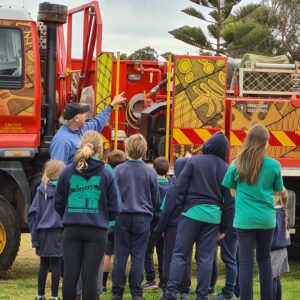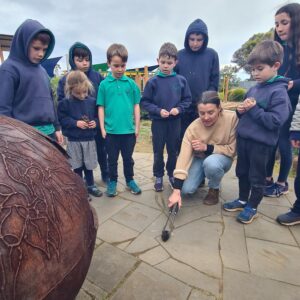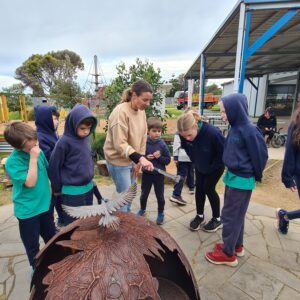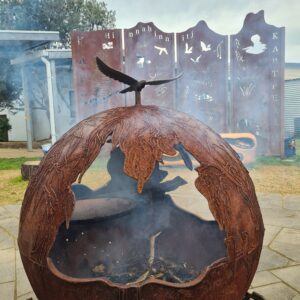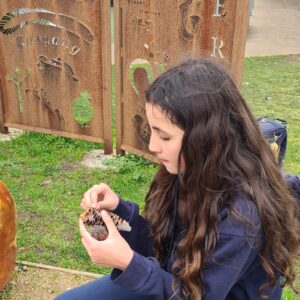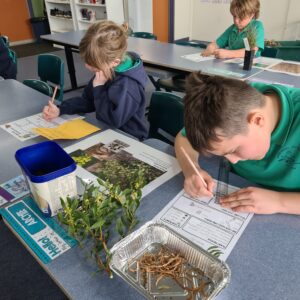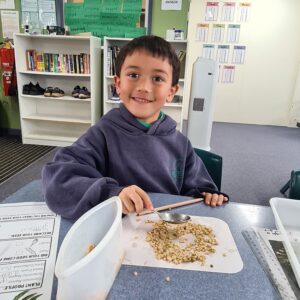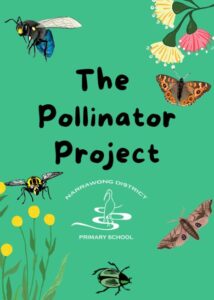

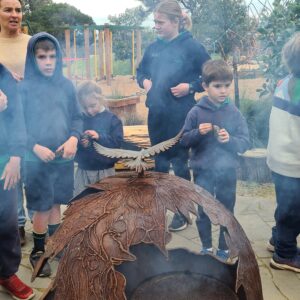
Pollinator Project
In 2023/4 we were fortunate to gain Junior Landcare funding to support a special Native Pollinator project. This project has seen a group of interested students from Grade F-6 embark on a workshop series exploring pollinator insects and plants within our local area. We've been very lucky to have the constant guidance of Lauren Kivisalu, evironmental consultant supporting us in this work.
The Pollinator Project educates students and community around the importance of insects. We’ve explored native pollinators, their habitats, pollinator plants, their importance to ecology and how pollination occurs. Students have participated in classification, seeding workshops, seed pod scarification, propagation and planting.
Our mission is to know who the insects are and how to look after them, recreate their habitats and help others do the same. We’ve learnt about the impact of humans on pollinators and plants, discovering what we can do to assist. The Pollinator Card game is designed to help everyone learn more about pollinators and pollinator plants.
Our project has raised public awareness of pollinators!
They may be little, but there's a lot to learn and celebrate about native insect pollinators. Insects such as native bees, flies, wasps, butterflies, moths and beetles are vita; to biodiversity and have many important roles in maintaining healthy ecosystems. They pollinate up to 90% of native plants; Banksias, Eucalypts, Tea-trees, Melaleucas, native grasses, and many rare and threatened plants including orchids.
Insects support other native animals through their role in the food chain. They pollinate up to 1/3 of our food crops and play other beneficial roles, including pest control and keeping soils healthy. More than 40% of native insects are in decline, 1/3 are endangered. We need to raise their profile and make a big deal about local native insects!
Pollinator Project Card Game
Learn more about our incredible pollinators! We've developed three games to help!
Contact the school on (03) 5529 5375 to find out more.
POLLINATOR MATCH
Players compete to make matches between 18 pairs of pollinators and plants.
Number of Players
2-4 players
Deck Composition
- 18 Pollinator Cards: Each card represents a unique pollinator (e.g., bee, butterfly, beetle etc.).
- 18 Plant Cards: Each card corresponds to one of the 18 pollinators (e.g., grass tree, swamp gum, sedge etc.).
Setup
- Shuffle the deck and deal 4 cards to each player.
- Place the remaining cards face down in a draw pile.
- Create a discard pile next to the draw pile (empty at the beginning).
Gameplay
- Turn Structure:
- On their turn, players draw 1 card from the draw pile or discard pile.
- If they have a match, they can play it in front of them.
- If no match can be made, they discard 1 card to the discard pile.
- Players must end their turn with 4 cards in hand.
- Matching:
- A match consists of placing a pollinator card with its corresponding plant.
- For example, blue banded bee with swamp flax lily, soldier beetle with swamp gum.
- Matches are placed in front of the player.
- Scoring:
- Each match is worth 2 points.
- Wild card matches are worth 1 point.
Game End
The game ends when:
- The draw pile is empty and players can no longer make any matches
- All 18 matches have been made
Winning
- The player with the most points at the end wins
POLLINATOR SNAP
Snap is a fun and fast-paced way to learn about pollinators and their corresponding plants!
Players race to spot matches between pollinator cards as they are placed on the table.
The first player to call out "Snap!" when a match appears, wins those cards.
Number of Players
2-4 players
Deck Composition
- Pollinator Cards: Each card represents a type of pollinator (e.g., bee, butterfly, beetle, moth, etc.).
- Plant Cards: Each card represents a plant that corresponds to a specific pollinator (e.g., grass tree, sedge, native flax lily, swamp gum, etc.).
This may be played two ways- either with 18 pollinator matches or 18 pollinator plant matches or alternatively with 18 pollinators/pollinator plants (36 cards total for each game).
Setup
- Shuffle all the cards together.
- Deal the entire deck evenly among all players, face down.
- Players keep their stack face down and do not look at their cards.
Gameplay
- Starting the Game:
- Players take turns going around in a circle.
- On their turn, each player flips over the top card from their pile and places it face-up in the center, creating a shared stack.
- Cards should be flipped quickly, and each new card should be placed on top of the previous card so that only the top card is visible.
- Spotting a Match:
- If a player notices that the top two cards on the stack are a matching pair (i.e., a pollinator and its corresponding plant), they call out "Snap!".
- A match is considered valid if, for example, a cuckoo bee card appears on top of a correa card.
- The first player to call out "Snap!" wins the entire center stack and adds it to the bottom of their own pile.
- Tie Situation:
- If two or more players call "Snap!" at the same time, the cards in the center are divided evenly between the tying players.
- If there is an odd number of cards, the last card remains in the center.
- Penalties:
- If a player calls out "Snap!" when there is no match, they must give one card from their pile to the player who flipped the last card.
- Out of Cards:
- If a player runs out of cards, they are out of the game.
- The remaining players continue until one player collects all the cards or a predetermined time limit is reached.
Winning the Game:
- The game ends when one player has collected all the cards.
- Alternatively, the game can end after a certain time, and the player with the most cards wins.
Tips for Players:
- Pay close attention to the types of pollinators and their matching plants, as it will help you spot matches more quickly.
- Be ready to shout "Snap!" as soon as you see a match, but be careful not to call it incorrectly!
POLLINATOR MEMORY (SINGLE or DUAL PLAYER)
Match pollinator cards with their corresponding plant cards.
Create as many correct matches as possible before the cards run out.
Deck Composition
- Pollinator Cards: Each card represents a type of pollinator (e.g., bee, butterfly, moth, beetle etc.).
- Plant Cards: Each card represents a plant that corresponds to a specific pollinator (e.g., swamp flax lily, swamp gum, muurang etc.).
NOTE: This game may be played with half the deck- just the Pollinator Insects or just the Pollinator Plants or a combination of both. Adjust the setup of rows to suit.
Setup
- Shuffle the cards together to form a single deck.
- Lay out 6 rows of 6 cards face down in a grid.
Gameplay
- Flip and Match:
- The player starts by flipping over two cards at a time.
- If the cards form a correct match (e.g., a banded bee card with a swamp flax lily), the player removes the matched pair from the grid and sets them aside.
- If the cards do not match, the player flips them back over to their original position.
- Using Memory:
- The challenge is to remember the location of each card after it is flipped back down.
- Continue flipping over two cards at a time until a match is made.
Scoring (Optional)
- Basic Scoring:
- 1 point for each matched pair.
- The goal is to get the highest score possible by matching all 18 pairs.
- Time Challenge:
- For an added challenge, the player can time themselves and try to beat their previous time.
Winning the Game
- The game is won when all pairs have been matched and removed from the grid.
Example of a Turn
- The player flips over a common brown butterfly card and a murnong card. These don’t match, so they flip them back over.
- Next, they flip over a resin bee card and a grass tree card, which do match! They set those cards aside and continue with the remaining cards.
- As they progress, they use their memory to recall where specific pollinators and plants are located, making matching more efficient.
LEPIDOPTERA MATCH
Players: 2-4
Deck Two decks needed. Take out pollinator cards that are not moths or butterflies
Setup
- Shuffle and deal 6 cards to each player
- Deal the cards evenly, face down
- Remaining cards placed in centre pile, face down
Gameplay
- Race to get a perfect hand of two sets of three matching cards- 1) moth or butterfly, 2) the matching larva plant (same coloured card) and 3) matching nectar plant
A matching nectar plant card is any plant card that has the same ‘flower type’ symbol as the moth/butterfly ‘flower type’ symbols you're matching to
- Take turns to draw a card from central pile
- Keep the card and replace with one from your hand (to a second central pile) OR reject the card picked up and place it in the second central pile
- Players must have 6 cards in their hand at all times
Out of Cards Flip over the second central pile and keep playing
End game: First player to complete their two sets of three matching cards
Fighting Extinction Showcase
In November, 2024 we presented our project to the public at Melbourne Zoo as part of the Fighting Extinction Showcase.
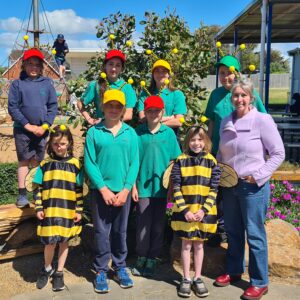 Lauren Kivisalu absent
Lauren Kivisalu absent


